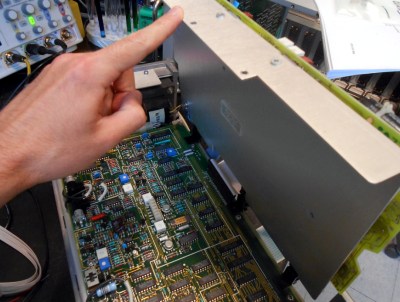You know how the saying goes — they don’t make them like this anymore. It’s arguably true of pretty much any electronic device given the way technology changes over time, though whether or not it’s objectively a bad thing is going to vary from case to case.
As a practical example, take a look at the insides of this 80’s vintage HP 3314A function generator shared on the EEV Blog Forum by [D Straney].

With multiple PCBs stacked on top of each other, it’s hard to imagine that more components could possibly be crammed into it. One board in particular appears to be an entire Motorola 6800 computer, something which today would likely be replaced with a single microcontroller.
Which is actually why [D Straney] shared this with us in the first place. After seeing our recent post about a modern waveform generator that’s basically an empty box thanks to its modern components, they thought this would be a nice example of the opposite extreme.
So, is it a good or a bad thing that test equipment isn’t made this way anymore? Well, it’s hard to argue with the improved capabilities, smaller footprint, and reduced cost of most modern gear. But damn is the inside of this HP 3314A gorgeous. As one of the commenters on the page put it, hardware from this era was really a work of art.
















Love these teardowns, so informative (even if it is about old tech) you can learn a thing or two about circuit design.
curiousMarc would agree on the declaration of ‘art’. He marvels and shows all the time the different counters, analyzers, time references HP has made over the years.
Too bad when its powered its STILL outgassing hazardous VOCs. I’ll take a modern Rigol any time over this old hunk of junk, at least in 10 years I won’t be suffering from unusual cancer.
Source of your claims about the outgassing – or are you just guessing? And do you really think that modern Chinese produced equipment are free from hazardous materials and outgassing?
I would guess that the more components there are, the more possible modes of failure there are, too? But on the other hand, it was likely built to higher standards, so that may cancel out.
The 3314 has shown up a couple previous times on HaD and as with previous mentions, my dad was the lead hardware engineer on this. It took some adjustment to get calibrated, and they went to some effort to make it easy to get to all the boards. I have other parts (lecroy scope) where you can’t even get to some of the boards you have to adjust during cal, while the scope is running, unless you build custom cable harnesses to allow you to move boards and parts out of the way. HP tried to make everything robust and avilable, so you could get to it easily. Their service manuals of the time list almost all the parts so you can replace almost anything (except for stuff like custom mask roms, like the 3314 had.) It was the first usable mainstream arbitrary waveform generator, and it’s pretty nice to use. Fun easter egg in there, too.
One calibration shop I worked for had a pamphlet cross-referencing HP part numbers in ICs to generic equivalent. But, ofc not all had OTS equivalents.
Yeah, I used to have a paper list of cross-references when I was working there, and there are some online. But I’ve never seen one that claimed to be complete, and HP made their own chips for a very long time.
See you can do these things much better without youtube. Nice pics, zoomable, and writeup, scrollable.
Us old folks remember how VCRs were often built to unfold their circuit boards to allow adjustments while a tape was running.
I’ve pondered gutting old faulty gear and replacing the internals with newer stuff as you can’t beat the quality of the front panel bits and the beefy power supplies (and the fact the thing weighs enough that it won’t scoot backwards off the bench when you push a button).
For all the nostalgia and great engineering in them, it’s kinda brilliant that we can buy something for $50 now that does the same job well enough for most of us.